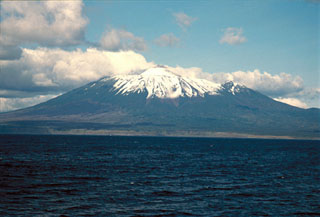Report on Chachadake [Tiatia] (Japan - administered by Russia) — August 1978
Scientific Event Alert Network Bulletin, vol. 3, no. 8 (August 1978)
Managing Editor: David Squires.
Chachadake [Tiatia] (Japan - administered by Russia) Explosion sound and vapor cloud
Please cite this report as:
Global Volcanism Program, 1978. Report on Chachadake [Tiatia] (Japan - administered by Russia) (Squires, D., ed.). Scientific Event Alert Network Bulletin, 3:8. Smithsonian Institution. https://doi.org/10.5479/si.GVP.SEAN197808-290030
Chachadake [Tiatia]
Japan - administered by Russia
44.353°N, 146.252°E; summit elev. 1822 m
All times are local (unless otherwise noted)
Residents of the E end of Hokkaido heard an explosion on 20 July at 1325. The explosion was not recorded by seismographs or microbarographs in E Hokkaido. Tiatia, approximately 50 km to the E, was obscured by fog. The next morning, the crew of the JMSA ship Kunasiri observed a white cloud rising 600 m from Tiatia, but heard no explosions. No ashfall was found (in Japan) on 20 or 21 July.
Geological Summary. The symmetrical Chachadake, also known as Tiatia, is on the SE side of northern Kunashir Island in the southern Kuriles. The active cone rises above the rim of a filled 2.1 x 2.4 km summit caldera with erosionally furrowed flanks. The central cone, mostly formed by basaltic to basaltic-andesite Strombolian eruptions, rises 400 m above the floor of the caldera and contains a 400 x 250 m wide crater with two explosion vents separated by a linear septum. Fresh lava flows cover much of the SW caldera floor and have overflowed the rim, extending to the foot of the older edifice, which formed during the late Pleistocene or early Holocene. A 500-m-wide crater about 2 km down the SE flank from the caldera rim is surrounded by an unvegetated area of volcanic deposits. The first recorded eruption was in 1812, and a major explosive eruption with lava flows in 1973 originated from vents on the central cone.
Information Contacts: JMA, Tokyo.

